Article content
It snowed.
Again.
Advertisement 2
Article content
Article content
Yeah, I know, I just told you guys about finally finding big flocks of snow geese barely two weeks ago so it seems a little soon to be telling you about the same thing again. But after that story appeared, I got a note from a kind gentleman named Paul. He let me know if I really wanted to see a big bunch of snow geese, I should head to McGregor Lake out by Milo.
True, I had just seen big flocks down at Keho Lake but the note from Paul convinced me it might be worth a look. And I do love snow geese. So on Tuesday morning, I headed for McGregor.
I wasn’t actually sure I would find any geese there. I had no doubt the big flock Paul mentioned had been there two weeks ago but it is, after all, the middle of November. Those geese could have easily continued on their way south and be somewhere around Texas by now.
Advertisement 3
Article content
But as I came over a hill just west of Milo, squinting into the rising sun, I saw two things that gave me hope. The first was that the sun was glinting off the ice-free waters of McGregor Lake. Open water means more birds.
The second thing was, there were geese flying around.
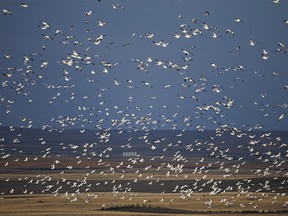
There were several small flocks of them winging their way to the grain fields just north of Milo where they joined other geese and ducks already breakfasting. But these weren’t snow geese. They were Canada geese.
The white-fronted geese were nice to see but the Canadas were, well, kinda ordinary. While a lot of them migrate through along with the snow geese, they are a common sight all year round in southern Alberta. Thousands of them spend the winter on the open water of the Bow River so they are, unlike snow geese, pretty easy to find.
Article content
Advertisement 4
Article content
It was still nice to watch them as they circled and landed but I didn’t watch them for long. After grabbing a couple of pictures, I headed over to the lake.

McGregor Lake is pretty big. Fed by canals carrying water from the Bow River, it runs from the lovely little town of Milo southward to where another canal carries its waters down to the Little Bow and Travers Reservoir. Surrounded by grain fields and native prairie pastures, it’s a man-made oasis out here in the dry, open country.
But there aren’t many public access points. You can see the lake from every angle but you can only get down to the shore at a couple of spots. I headed for the closest one.
There’s a little campground and a boat launch ramp in the northwest corner of the lake right by Milo, so I left the feeding geese and drove straight there. And, much to my surprise, I found the little shallow bay there was ice-free.
Advertisement 5
Article content
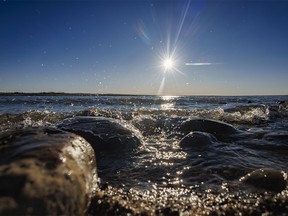
I already knew the main body of the lake was open. It has been pretty warm the last while and with the wind blowing, wave action would slow down any freezing. But the sheltered bays at Keho Lake had been frozen over two weeks before so I figured this one would be, too.
Nope. So I parked and walked down to the beach for a look.
The wind was starting to pick up and small waves were banging against the shore so I put on my wide-angle lens and laid down to shoot some pictures as they broke on the rocks. As they did, of course, they splashed the front of my lens so after a few minutes I sat back up again to wipe it off.
And as I did, something crunched underneath my elbow. A tiny, lobster-like claw.
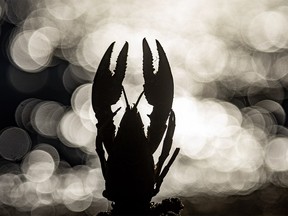
I had already known there were crayfish in McGregor Lake. In fact, over the last couple years, crayfish have been popping up pretty much everywhere. They’re not native in any of the waters where they’ve lately been found but they have somehow become ubiquitous in southern Alberta.
Advertisement 6
Article content
Up until that moment, though, I’d never seen any sign of them at McGregor. Now, as I sprawled out on the shore, they were everywhere.

They were mostly in pieces, a shell here, a claw there. They shed their exteriors as they grow so that wasn’t a surprise. Birds and other critters eat them, too, so that would have added to the accumulation as well. But there were some whole ones, too.
And they were big. A couple of them were as long as my hand and twice the thickness of my thumb. I’ve eaten them before, a couple of times, down in Louisiana and Texas, and they were pretty tasty. These ones looked every bit as good.

OK, not these particular ones. They were all either fresh and frozen into the sand, or dried out and crunchy. But if there was all that crustacean clutter on the shore, there must be hundreds of them — or maybe thousands of them — out there on the lake bottom.
Advertisement 7
Article content
And they weren’t the only interesting thing along the shoreline. In among the crayfish parts were snail shells. But not the usual fingernail-sized shells we’re used to seeing. No, these ones were huge.

The majority of them were the size of walnuts, some even approached the dimensions of a small plum. I never found any that were wholly intact but they were easily four or five times bigger than any snail I’ve ever seen anywhere in Alberta. What they were, I had no idea but I looked them up when I got back home.
According to the internet, these are — and I swear this is the name I found — Chinese mystery snails. They were apparently brought to North America by Asian immigrants more than a century ago and now, after all that time, they have somehow found a home here in McGregor Lake.
Advertisement 8
Article content
Add another exotic to the list.
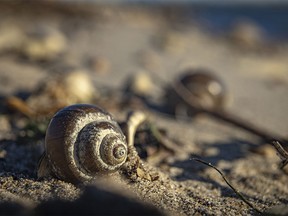
The wind was picking up now, sweeping across the water from the southwest, so I hopped back into the truck and went to the second public access point, another boat launch along the eastern shore.
This one lies south of Milo, about a third of the way down the lake, and, unlike the first one on the sheltered bay, sits right on the main section. With the wind blowing the way it was, I was hoping I might find some good-sized waves hammering the shore.
And I did. But what I at first took to be whitecaps out on the water turned out to be geese. And when I put on my longest lens for a better look, I could see that there were a lot of them.

So the snow geese that Paul had written to me about were still there, at least some of them. But I couldn’t see them very well from where I was so I drove a little farther down the lake.
Advertisement 9
Article content
And there weren’t just some. There were hundreds and hundreds of them scattered in solid white masses on the water. Beyond them, on the hills to the west, there were hundreds more sitting in the fields.
Paul wasn’t kidding when he said there were thousands of them. Even with the limited view I had from the road, I could see there were easily as many geese as I had seen at Keho Lake two weeks ago, and almost certainly more.
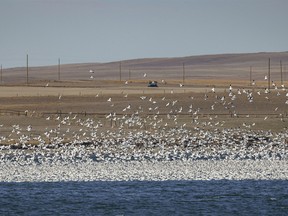
But I couldn’t see them very well so I left the crashing waves behind and drove back around to the west side of the lake for a better view.
My timing was off, though. While I had been playing around with the crayfish and giant snails, the geese had finished their breakfast and were headed back to the water. The fields I’d seen covered in geese from across the lake were now mostly bare.
Advertisement 10
Article content
But if they had taken their first meal of the day in those fields, I figured they’d likely come back to roughly the same place for supper. Now that I knew where they had been, I could come back here, too.
That wouldn’t be for several hours, though. So I kept on driving south.
I tried to find other vistas of the lake as I went but pretty much the entire shoreline is on private land and I certainly wasn’t going to trespass even just to have a look. But I found other stuff, too.
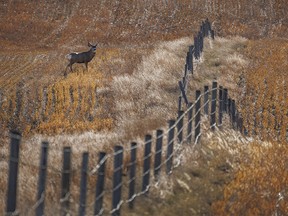
The fencelines here were jammed with tumbleweeds blown across the snowless fields and they bounced silvery in the wind. I found deer out in the orange-coloured pea fields taking advantage of the leftover bounty and near the south end of the lake just before it enters the canal to flow on to Little Bow, another big flock of Canada geese.
Advertisement 11
Article content
I wasn’t actually going to bother with them but they did look interesting in the way they lined the shore so I stopped for a shot. And as I did, a roar came up from around the bend and a huge flock of snow geese flew in. It wasn’t as big as the flock further up the lake but there were hundreds of them, their white bodies shimmering in the mid-day sunlight.

To think I was whining a month ago about not seeing any snow geese and now …
Clearly, I really have to reset my snow goose calendar.
Since I was close, might as well try Travers, too. Same thing, big flock in the air. A nice mulie buck relaxing and gophers running around, too. Five bald eagles patrolling the shoreline as well.
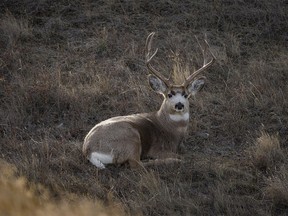
And over at Williams Lake south of Lomond, one huge flock of snow geese I couldn’t get close to on the south shore and a thousand or more right beside the road on the north shore. Wigeons, mallards and swans, too.
Advertisement 12
Article content
But by now it was getting on to three in the afternoon and dusk — thanks to our shortening days — was approaching. So, with my memory cards already full of snow goose pictures, I headed back to where the McGregor birds had been feeding to shoot some more.
It was 3:30 when I started to photograph them flying over me and 10 past four when I finally moved over to where most of them had landed. And there were still birds flying in from the lake. In front of me, above me, all around me, there were snow geese. The number was uncountable. Through my long lenses they filled my frame in a solid mass and shooting upward with my widest-angle lens, the sky was stitched with skeins of them from horizon to horizon. The sound, like it had been at Keho Lake before, was nearly deafening.
Advertisement 13
Article content

And as the sun dipped below the horizon they were still on the move, flying from the lake and back again, moving from field to field. Finally, it was just too dark to keep on shooting so I headed back to the lake myself.
From the dam on McGregor’s northern end, I looked back across the rippling water toward the technicolor sky that was exploding in the west and saw a line of birds silhouetted against the apricot sky beyond. Canada geese, maybe some of the same ones I’d seen just after sunrise that morning, heading back to the lake for the night.
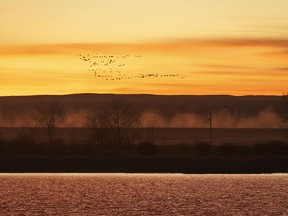
Back to the lake that I now knew held crayfish and giant mystery snails and for the moment, at least, thousands of snow geese.
Thank you, Paul, for letting me know about them. I never would have seen them otherwise.
And thank you, McGregor Lake, for being the wonderful place that you are. I know many reservoirs are drying up and water is getting short but you truly are a prairie oasis and I hope that you stay that way.

And that the snow geese return to your waters next spring.
I’ll be watching for them.

Article content
Comments
Postmedia is committed to maintaining a lively but civil forum for discussion and encourage all readers to share their views on our articles. Comments may take up to an hour for moderation before appearing on the site. We ask you to keep your comments relevant and respectful. We have enabled email notifications—you will now receive an email if you receive a reply to your comment, there is an update to a comment thread you follow or if a user you follow comments. Visit our Community Guidelines for more information and details on how to adjust your email settings.